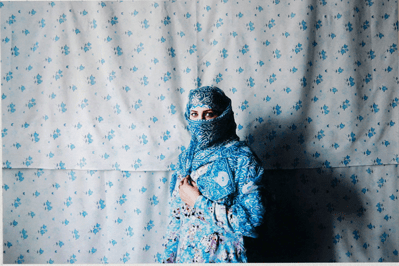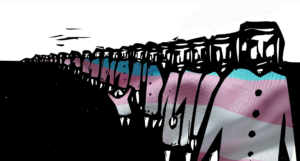Almond Garden
The Badam Bagh ("Almond Garden") penitentiary on the outskirts of Kabul, Afghanistan, is home to many incarcerated women whose stories are told in photographs and text in a new book by Gabriela Maj, a Polish-Canadian photographer based in Dubai, United Arab Emirates.

Daylight
“Almond Garden: Portraits from the Women’s Prisons in Afghanistan” A book by Gabriela Maj
Gabriela Maj, a Polish-Canadian photographer based in Dubai, had traveled to Kabul in 2010 for an assignment on an Afghan artist when she received a request to photograph the notorious women’s prison in Badam Bagh penitentiary, on the outskirts of the capital city. That visit had a powerful impact on Maj. Inspired by the fortitude of many of the Badam Bagh inmates and their desire to create a better future for their children despite suffering horrific abuses, Maj embarked on an ambitious four year project documenting the lives of incarcerated women from inside several prisons throughout Afghanistan. Their portraits and stories have been compiled together in the monograph “Almond Garden” — English for “Badam Bagh.”
The book is a compelling, enlightening visual essay, exposing the unspeakable injustices inflicted upon women and girls, some as young as 13. The intimate conversations collected offer a rare chance for these women to tell their side of the stories. It’s evocative of W. Eugene Smith’s photo essays of social injustices.
The first half of the book is filled exclusively with 67 color portraits, followed by a section of individual testimonies detailing the various circumstances leading to incarceration. I questioned at first the unconventional layout of photographs without captions or corresponding page numbers connecting to the section of text. This was intentional. Separating these elements suspends judgment and keeps the women in the portraits from being defined by their alleged crimes. Names have also been changed to protect their identity.
On a return trip to one of the prisons, Maj passed out pictures to the women she had previously photographed. A young woman immediately snatched her photo and blew into a heated tirade. The interpreter informed her the previous prison director was using the pictures to solicit their “services” to men outside the prison.
The majority of women in prison are serving 5- to16-year sentences, convicted of zina — moral crimes strictly prohibited by Shariah law such as sex between two unmarried people. Most of the female inmates were incarcerated after being raped, forced into prostitution, involuntary pregnancy and running away from forced marriages. In 2014, Human Rights Watch estimated 95 percent of girls and 50 percent of women imprisoned in Afghanistan had been accused or convicted of zina.
“Woman that run away from abuse at home are tracked down like criminals by the police while their assailants go unpunished,” Maj writes. “Accomplices that aided in their escape are also imprisoned.”
One woman, Farideh, was distraught when her abusive, much older husband sold their young daughters to settle debts. Farideh escaped her home with the help of another man. Both were arrested. Farideh’s husband was allowed to torture her abettor with electrical wires.
In a culture in which having a daughter is a dishonor for parents, girls are sold off to much older men in arranged marriages, regardless of a 2009 ban on underage and forced matrimony.
Married at 15 to a 70-year-old abusive husband, Nazir ran away with another man. Her husband tracked them down and took the couple to the Taliban who tortured the young man.
Despite the 2009 passage of “the Law of Elimination of Violence against Women,” the legislation was never ratified by the Parliament. In fact, laws have been heading backward into the Stone Age with proposed amendments making it illegal to question relatives in rape cases, and incidents of women who have been accused of zina being stoned to death. According to Human Rights Watch, “running away,” or fleeing home without permission, is not a crime under the Afghan criminal code, but the Afghan Supreme Court has instructed its judges to treat women and girls who flee as criminals.
Although it is extremely dangerous for women to talk openly about their feelings, Maj was able to establish a level of trust and comfort with the inmates. She credits her unparalleled access to her gender. In the eyes of the male prison officials, a foreign female photographer did not pose a threat. The few occasions authorities attempted to deny her entrance, Maj’s Polish passport became her golden ticket. Guards and police would enthusiastically strike up a conversation about the city of Krakow and the shared history of Soviet oppression between Poland and Afghanistan.
Accompanied by Afghan translators, Maj was mostly left alone with the female inmates who revealed their intimate stories.
Maj’s portraits are a revelation in their unexpected familiarity. Absent are standard issue frumpy prison jumpsuits. Instead, women are dressed in brightly patterned fabrics, street attire or traditional yet stylish burkas. Her wide-angle composition captures the colorfully painted cells, decorated with makeshift curtains and an array of patterned wool rugs accentuated with personal trinkets. Televisions placed on top of refrigerators and small vases filled with plastic flowers create a homey feel. Neatly made beds adorned with pink dust ruffles, stacked blankets and a collage of beauty magazine pages and family photos taped on the walls transform cells into a dorm-like environment.
Many of the women wear headscarves or veils in their photos. A sense of shame, meekness, confusion and defiance emanate from them. Others look relieved or gleam with motherly pride. They appear alone, with their children, or in pairs. One image resembles what might otherwise be a generational family portrait — an elderly woman, a mother and child. The mother proudly displays a vintage sewing machine in the foreground. Painted nails, a touch of makeup and hands bejeweled with gold rings create an illusion of normalcy. The small creature comforts are a bit deceiving, allowing us to temporarily forget the deplorable conditions that led them to prison.
But not everyone is unjustly incarcerated. Many are guilty.
A lack of education, stunted mental and emotional growth are combined with years of brutal abuse in many of these women. Some of them see no legal way out of their horrific situations. Some resort to self-immolation. Some simply snap.
Engaged at the age of 3 and married at 14, Nafisah’s husband became a drug addict. Unemployed and in debt, he pimped her out one night to a man who raped her. “After this my mind became very confused,” the mother of three said. “I put a tablet in his tea and when he fell asleep I took the knife and cut his throat.” Mental health support in the system is nearly nonexistent. Maj writes of an encounter with a smartly dressed woman while waiting on a cot in a guard’s booth. She was employed as a mental health professional at several facilities, yet her education was in the dental field. The woman remarked that most of the incarcerated women lie and should not be trusted. She went on to say that the inmates suffer from a type of mania that induces uncontrollable promiscuity. It was genetic and had nothing to do with the stress in their lives.
Married at the age of 9, Nargis turned herself in to the police to escape a violent home. Her husband divorced her, taking custody of her children. Accused of being a bad mother, her family abandoned her. Nargis’ psychological stress manifests in physical symptoms such as uncontrollable shouting and trouble walking. The counselor’s remedy: splashing cold water in her face.
Allegations and basic facts are often difficult to confirm. Ages are estimated, laws change and sentences are altered due to bribes.
There are no bars on the windows. Prisoners move about freely with 5 to 10 women per cell. The lack of segregation among the prison population, however, means women accused of “moral crimes” and their young children commingle with convicted drug traffickers and murderers.
As dismal as prison may be, many women fear being released, citing death threats or further torment from their husbands and families. The only viable alternative is refuge in one of the country’s 20 Western-funded women’s shelters.
Maj’s sensitive, eye-opening investigation has given a voice and a face to women who have been denied basic human rights for far too long.
“Monitoring women for moral crimes perpetuates a system of legitimized violence,” Maj writes. “As long as men and women are denied the freedom to choose their spouse, there will be suffering and violence as a result. And as long as women’s bodies are regarded as property to be owned, bought, and sold, a war against them in the name of morality will continue.”
Advance copies of Almond Garden are available on almondgarden.net; a portion of the proceeds will benefit Women for Afghan Women, an NGO dedicated to advancing women’s rights in Afghanistan.
With an uncertain future and a new administration casting doubt on press freedoms, the danger is clear: The truth is at risk.
Now is the time to give. Your tax-deductible support allows us to dig deeper, delivering fearless investigative reporting and analysis that exposes what’s really happening — without compromise.
Stand with our courageous journalists. Donate today to protect a free press, uphold democracy and unearth untold stories.






You need to be a supporter to comment.
There are currently no responses to this article.
Be the first to respond.